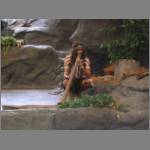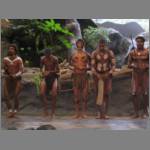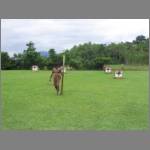
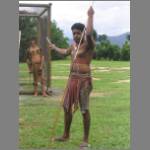
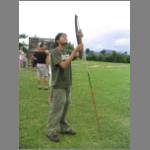
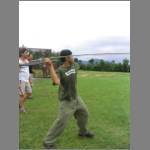
It's hard to define exactly what Tjapukai is: amusement park? cultural attraction? Aboriginal show venue? I'm not certain how to name a place where one can learn to throw boomerangs and spears (very hands-on as the pictures will tell you), hear Aboriginal music (yes, including the didgeridoo) and see dancers with ceremonially painted bodies, observe extracts from Tjapukai mythology with holographic special effects, and sadly contemplate the modern history of Australian tribes presented in a documentary. Oh yes, the cool-sounding word "Tjapukai" is the name of one Aboriginal tribe, whose surviving members largely own and are employed at the park which successfully shares their culture and history with the visitors in educational yet fun ways.
We particularly enjoyed the open-air sections of the park, namely, the boomerang- and spear-throwing fields. After trying my hand at these skills, I am amazed that Aborigins remained a society of gatherers and hunters for the entire 40,000 years of their presence in Australia, and did not develop a farming culture, because killing anything that moves above koala speed with these weapons seems an impossible task to me. Moreover, as we discovered at the presentation of bush foods, nothing found in Australian forest ("bush") is immediately edible. Nearly all the things that later become food are originally highly poisonous and require weeks of treatment before they can be safely consumed! Plus, there's little food available in the wet season (which lasts half a year) when hunting and simply moving around becomes quite difficult. The adaptation of Aborigins to such harsh living conditions is marvellous, and makes their fate upon meeting the white man all the sadder to think about.
Surely you are familiar with the story, which repeated itself many times over on different continents: the indigenous people lived in harmony with nature, didn't hunt their <insert local animal species here> to the extinction, made offerings to their exotic gods, painted their bodies but didn't wear much clothes, and had no clue that life could ever be different. Then came the civilized westerner, saw much valuable land, shuddered at the sight of naked local bodies, and started spreading culture by way of cold steel and fire. By the time the westerner felt sorry for the locals, there were just a few left in reservations, and the natural habitat was also destroyed, so the white man created national parks and museums of indigenous culture to preserve the remnants. I give you -- Tjapukai Aboriginal Cultural Park!!!
While this unoriginal tale, well told in the documentary of the History Theatre at Tjapukai, may inspire sadness and a tinge of guilt in the audience, the rest of the park is fun and entertaining. The live actors mixed in with advanced holographics at the Creation Theatre put on a very impressive show that gives you an idea of the Aboriginal beliefs about the origins of the universe and mankind, but leaves you a bit confused about who of the two brothers, representing the Dry and the Wet (two seasons of tropical Australia, associated with concepts of Good and Evil) killed the other one and in divine punishment lost his leg to a crocodile who had been created by one of the siblings. Then again, I am habitually confused about Cain and Abel's respective occupations... which one was the sheppard, again? I won't even get into the blood relations between Hindu gods and goddesses; I suppose all mythology tends to be complicated.
At the traditional Aboriginal camp we saw the "bayu"
-- waist-high rounded bush huts made of leaves,
bark and vine, and learned about bush foods and
medicines (both highly toxic, as I've already
mentioned). Our attempts at throwing spears and
boomerangs are illustrated below with photographs.
Don't miss the expression on Puneet's face as
the boomerang leaves his hand, it's precious!
He turned out to be a natural at this craft,
by the way. Can't wait to find an empty parking
lot back in the States and see him launch our
"original hand-crafted returning boomerang" that
we got from the gift shop. Supposedly all goods
there are made by Aborigins and not imported
from China, and the sales benefit the Tjapukai
community. They also had paintings and other
artsy items decorated with Aboriginal patterns
(stylized Australian animals, plants and geometric
figures, all intertwined), very pleasing
to the eye, some striking in their
complexity and beauty of design. I noticed similarities with Indian (Native
American) motives, and realized that such style
in art, especially as applied to home decor,
has become quite popular with the yuppie US crowd.
The wheel of history turns in funny ways.
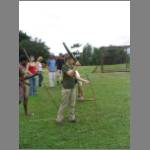
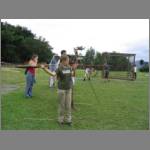
Above: Learning all about the art of spear throwing, Aboriginal
style of course.
Given our prowess with the spears,
we're lucky we had hummus sandwiches
for lunch because we would have
gone hungry if we'd had
to kill anything for food!
Putting the spears on the throwing
sticks was a case of "no worries",
the only problem was what happened
when we actually tried to throw
them... In every case the spears
would end up ten feet from us
sticking straight up in the ground.
Given another hour or so of
practice I'm sure we'd have
been pretty decent hunters.
Below:
After learning to spear, we had
a go at throwing boomerangs with the help of the wonderful staff
at the park. Puneet had pretty good beginner's luck and actually
managed to get the boomerang
to return toward him (but he
didn't catch it or anything).
We picked up a couple of boomerangs
to continue practicing when we
return home, provided we can
find a small field for practice.
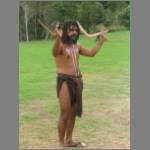
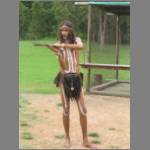
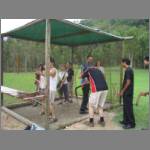
Below: Some other sights from the Tjapukai park: a member of the staff playing
the didgeridoo (an Aboriginal instrument that has an odd twangy sound -- you've
probably heard it as it is the stereotypical Australian sound), a picture of
the aboriginal dancers and a glimpse of the incredible beauty of the park.
